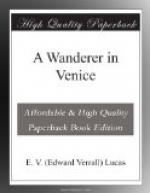The picture, which I reproduce on the opposite page, is on an easel just inside a door and you come upon it suddenly. Not that any one could ever be completely ready for it; but you pass from one room to the next, and there it is—all green and blue and glory. Remember that Giorgione was not only a Venetian painter but in some ways the most remarkable and powerful of them all; remember that his fellow-pupil Titian himself worshipped his genius and profited by it, and that he even influenced his master Bellini; and then remember that all the time you have been in Venice you have seen nothing that was unquestionably authentic and at the most only three pictures that might be his. It is as though Florence had but one Botticelli, or London but one Turner, or Madrid but one Velasquez. And then you turn the corner and find this!
[Illustration: THE TEMPEST FROM THE PAINTING BY GIORGIONE In the Giovanelli Palace]
The Venetian art that we have hitherto seen has been almost exclusively the handmaid of religion or the State. At the Ducal Palace we found the great painters exalting the Doges and the Republic; even the other picture in Venice which I associate with this for its pure beauty—Tintoretto’s “Bacchus and Ariadne”—was probably an allegory of Venetian success. In the churches and at the Accademia we have seen the masters illustrating the Testaments Old and New. All their work has been for altars or church walls or large public places. We have seen nothing for a domestic wall but little mannered Longhis, without any imagination, or topographical Canalettos and Guardis. And then we turn a corner and are confronted by this!—not only a beautiful picture and a non-religious picture but a picture painted to hang on a wall.
That was one of Giorgione’s innovations: to paint pictures for private gentlemen. Another, was to paint pictures of sheer loveliness with no concern either with Scripture or history; and this is one of his loveliest. It has all kinds of faults—and it is perfect. The drawing is not too good; the painting is not too good; that broken pillar is both commonplace and foolish; and yet the work is perfect because a perfect artist made it. It is beautiful and mysterious and a little sad, all at once, just as an evening landscape can be, and it is unmistakably the work of one who felt beauty so deeply that his joyousness left him and the melancholy that comes of the knowledge of transitoriness took its place. Hence there is only one word that can adequately describe it and that is Giorgionesque.
The picture is known variously as “The Tempest,” for a thunderstorm is working up; as “The Soldier and the Gipsy,” as “Adrastus and Hypsipyle,” and as “Giorgione’s Family”. In the last case the soldier watching the woman would be the painter himself (who never married) and the woman the mother of his child. Whatever we call it, the picture remains the same: profoundly beautiful, profoundly melancholy. A sense of impending calamity informs it. A lady observing it remarked to me, “Each is thinking thoughts unknown to the other”; and they are thoughts of unhappy morrows.




